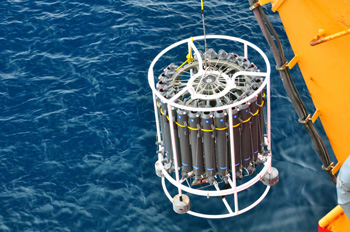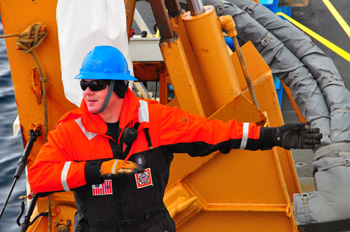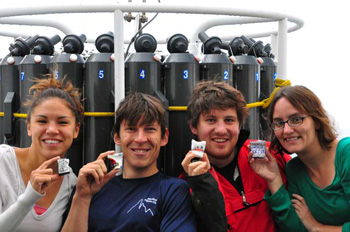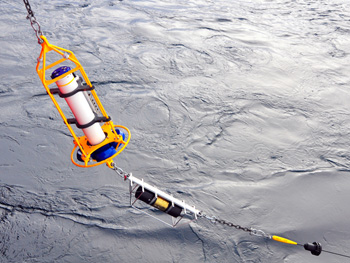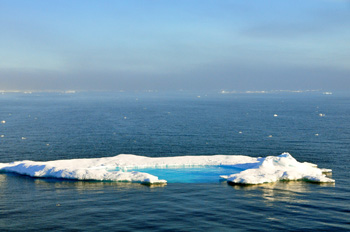September 17thThe sea is dead flat again today. It’s cold, the fog has lifted, but the wind remains very light. I’d expected a blow by now. I’m not certain if this is typically gentle weather or we’ve just been lucky. The old hands say storm season generally doesn’t get started until late September or early October, but they’ve seen a lot heavier weather this time of year. We’re now steaming fast, 17 knots, for the ice, aiming at a spot about 120 nautical miles from our position at 1000. I was surprised at Healy’s turn of speed for such a heavy ship—until our tour of the engine room last week. This vessel has power, but I’d figured most of it would be dedicated to torque for icebreaking, not top-end speed.
Actual measuring work has ceased while we steam for the ice, but Bob remains at his computer, as he has every day, parsing and processing data from the moorings and from that fundamental oceanographic workhorse, the CTD. Please see the photo in this page; that’ll save me bothering you with a description. The CTD measures those fundamental ocean characteristics salinity, temperature, and depth, but it can be stocked with additional sensors. So far in this trip the CTD has been lowered through the water column to near the bottom and raised 140 times with many more “casts” to come. There are two CTD watches working 12 hours on 12 off day and night. Typically, Dr. Bob plots “transects” across particular sections of ocean, most athwart the Western Arctic Boundary Current, that he needs to profile. Remember we said that the ocean tends to layer or stratify itself according to temperature and salinity, and that the identity of the water can thus be determined? So as the package of instruments mounted on the CTD passes through the water column they reveal its vertical structure. Bob can then identify the deep warm, saline Atlantic-origin water underlying the cold, fresher Pacific-origin water near the surface. And by doing multiple casts in a line across the current, he can obtain a horizontal as well as vertical profile of the current. That’s why the CTD is used on every fizzo cruise. If oceanography were carpentry, the CTD would be something really basic like a tape measure or a hammer. It’s often called the “package,” because it’s handy platform for a collection of instruments to be sent toward the bottom (don’t hit it). Many CTDs include an ADCP (fizzo sports nearly as many acronyms as the military), which measures the speed of the current by bouncing a pulse of sound off of any particles passing above or below the instrument, just like the sonar scenes in submarine movies. By measuring the return pulse, the ADCP knows how fast the particle and, therefore, the current is moving. A lot of oceanographic tools use sonar variations because sound travels very effectively through seawater.
Those grey bottles like skinny scuba tanks are to collect water samples. On the way down the bottles remain open, because a closed bottle full of air would be crushed flat by the pressure. They can be closed remotely, “fired” in the parlance, with a computer keystroke by the CTD watch operator. Many an oceanographer began his/her career as a graduate student standing CTD watch in the middle of the night, recording temperature-salinity-depth info on the CTD form. The water samples have various uses depending on the cruise objectives. We have researchers aboard measuring nutrients in the samples to learn the biological productivity of the water; others are looking for phytoplankton captured when the bottle was fired. You can also sample oxygen, salts, nitrogen, and other revealing contents. There is a venerable oceanographic tradition associated with the CTD and the fact that it goes down very deep. You collect Styrofoam cups and you and your shipmates write notes or make drawings on them for your friends and loved ones, enemies too, I suppose. You put the cups in a mesh bag, lash it to the CTD frame, and send it down, as they did yesterday, about two miles. When you haul the CTD back to the surface (this requires a powerful winch, by the way, since the package weighs about one ton) your cups have been squeezed by ocean pressure down to the size of a thimble. I’ll bet every physical oceanographer in the business has at one time or another crushed cups on a CTD. * * * An interesting thing: We were up on the bridge watching the air-temperature gauge. The temperature was fluctuating several degrees up and down, and with each rise the fog flowed in and with each drop it went out. Warm air over cold water equals fog. That’s why there’s seldom fog in the tropics. But I’ve never seen fog come go and so quickly. * * * Speaking of the ADCP, this instrument is as common these days as the CTD itself. One variety is lowered on the CTD and/or mounted on moorings that remain in the water for a year or so. And most oceanographic research vessels, including Healy, have ADCPs mounted in their hulls pinging away 24 hours a day. Frank is our ADCP guy. His job is, in addition to tending to the instruments themselves, to process the raw data. As for the shipboard ADCP, he needs to factor out of the data the ship’s speed and course, and when that’s done he’ll have a constant record of current velocity down to about 300 meters for all waters the ship passed through. It’s worth remembering that these things are relatively new, really smart technological solutions to a difficult problem—how to measure an ocean—but now they’re commonplace, part of the day-to-day vocabulary of fizzo.
As of about 1600 (4:00 pm) isolated ice floes suddenly appeared. It’s probably first-year ice that formed last winter, but, like everything else about the ocean, sea ice is not simple. It comes in a wide variety of forms depending on an equally wide variety of factors. I’m not sophisticated enough to distinguish first-year from multi-year ice, but I’ll learn a lot from experience in the next few days and from the onboard experts. I’ll pass it on to you. As I write this at 1630, Healy shudders every now and then. That must mean the ice is thickening—she’s running over floes instead of steering around them as she was doing an hour ago. Also, the active lab is empty, which must mean my shipmates are topside watching ice. I’ll join them…. Yep, it’s getting thick.
Last updated: September 28, 2010 | |||||||||||||||||||||||
Copyright ©2007 Woods Hole Oceanographic Institution, All Rights Reserved, Privacy Policy. | |||||||||||||||||||||||
